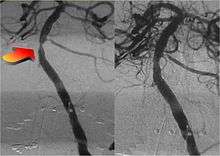Interventional neuroradiology
Interventional Neuroradiology (INR) or Endovascular Surgical Neuroradiology (ESN) is an Accreditation Council for Graduate Medical Education (ACGME) and European Union of Medical Specialists (UEMS) medical subspecialty specializing in minimally invasive image-based technologies and procedures used in diagnosis and treatment of diseases of the head, neck, and spine.
History
Diagnostic angiography
The first experience with cerebral angiography was developed by Portuguese doctor Egas Moniz at the University of Lisbon, in order to identify central nervous system diseases such as tumors or arteriovenous malformations. He performed the first brain angiography in Lisbon in 1927 by injecting iodinated contrast medium into a carotid and using the rays discovered 30 years earlier by Roentgen to visualize the cerebral vessels. In pre-TC and pre-RM, it was the only tool to observe the structures within the skull and was also used to diagnose extravascular pathologies.
Subsequently, European radiologists further developed the angiographic technique by replacing the traumatic direct puncture with catheterization: in 1953, Swedish physician Sven Seldinger introduced the technique of arterial and venous catheterisation still in practice. In 1964, the Norwegian radiologist Per Amudsen was the first to perform a complete brain angiography with a transfemoral approach, as it is performed today; he then moved to San Francisco to teach the technique to american neuroradiologists. These two stages, at the basis of modern invasive vascular diagnostics, prepared the way for later therapeutic developments.
The first treatments: balloon occlusion
The first to carry out a true endovascular treatment was Charles Dotter, the father of the angioplasty and considered by many as the father of all interventional radiology as well as the first to have performed endovascular treatment. On January 16, 1964, he performed a therapeutic angioplasty of a superficial femoral artery in a 82-year-old woman with an ischemic leg refusing amputation. The artery remained open for the next 2 and a half years after which the woman died of pneumonia.
In the 1970s Fedor Serbinenko developed a technique for closing aneurysms with balloons that were released into the internal carotid artery by occluding the light. The first treatment was performed in 1970 in Moscow, with the occlusion of an internal carotid to treat a carotid-cavernous fistula. He can be considered, therefore, the first interventional neuroradiologist. This technique was subsequently refined by neuroradiologists all over the world: the first and most brilliant were Gerard Debrun in Canada, Grant Hieshima in San Francisco and Jacques Moret in Paris.
Parallel to the development of catheters, in the radiology and neuroradiology units, image technology dramatically improved: Charles Mistretta in 1979 invented digital subtraction angiography (DSA), the technique currently in use. It consists of performing skull radiography under basic conditions which is then "subtracted" to the image after contrast media injection, to provide an image where only brain vessels are displayed, with great improvement in the diagnostic potential.
The coils replace the balloons
Between the end of the '80s and the beginning of the '90s, INR was suddenly revolutioned after the work of two italian physicians: Cesare Gianturco and Guido Guglielmi. The first combined a ∂eep knowledge of diagnostic radiology with a great ability to solve technical and manual problems. He invented Gianturco's coils, which he used to make the first attempts to embolize arteries and aneurysms. Gianturco also patented the first endovascular stent approved by the American FDA; a device with a great legacy. In the second half of the 1980s, Hilal was the first in Columbia University to use coils to treat brain aneurysms; but this technique was inaccurate and dangerous because the coils were released with little control with great risk of occluding the vessel from which the aneurysm originated. The coil embolization was revolutionized by the work of Guido Guglielmi in UCLA, who realized that electricity could function as a controlled release mechanism for coils; in 1991 he published two works dealing with the embolization of brain aneurysms by means of detachable platinum coils (Guglielmi's coils). The treatment of aneurysms was thus made more accessible and safe.
New techniques: flow diversion stents
Since the early '2000s, it was observed that intracranial stents positioned to keep the coils in the aneurysmal sac favored the redirection of blood flow, helping to exclude aneurysm from the circus. Flow diversion devices were lately developed, with the function of reconstructing the vessel's normal anatomy without directly closing the aneurysm neck and therefore preserving side branches (in the brain the placement of stents covered is highly unlikely for the risk of closing small side branches and cause an ischemia).
Not just hemorrhages: the treatment of ischemic stroke
Between January and June 2015, 5 major randomized trials were published on the New England Journal of Medicine with the collaboration of interventionist neuroradiologists and neurologists (in the Netherlands, Canada, Australia, USA and Spain) regarding the role of mechanical thrombectomy in the treatment of ischemic stroke, demonstrating that if it is performed in centers with proven experience, intra-arterial mechanical thrombectomy is more effective than traditional treatment (intravenous thrombolytic injection).
Thrombectomy is today highly recommended by the guidelines written by the main american (AHA/ASA) and European (ESO-ESNR-ESMINT) societies of stroke neurologists and interventional neuroradiologists [1][2].
Diseases and conditions


The following is a list of diseases and conditions typically treated by neurointerventionalists.
- Cerebral aneurysm
- Brain arteriovenous malformation (AVM)
- Carotid-cavernous fistula (CCF)
- Dural arteriovenous fistula
- Extracranial (brachiocephalic) atherosclerosis
- Extracranial (head and neck) and paraspinal vascular malformations
- Head and neck tumors
- Intracranial atherosclerosis
- Juvenile nasopharyngeal tumor
- Meningiomas
- Nosebleeds
- Paragangliomas
- Stroke
- Spinal vascular malformations
- Traumatic vascular lesions
- Vasospasm
- Vertebral body tumors
- Vertebral body compression fractures
See also
References
- ↑ http://www.strokeassociation.org/STROKEORG/AboutStroke/Treatment/Stroke-Treatment_UCM_492017_SubHomePage.jsp. Missing or empty
|title=(help) - ↑ http://www.strokeassociation.org/STROKEORG/AboutStroke/Treatment/Stroke-Treatment_UCM_492017_SubHomePage.jsp. Missing or empty
|title=(help)